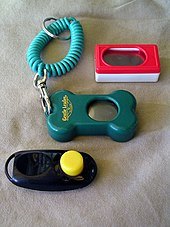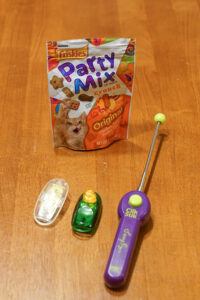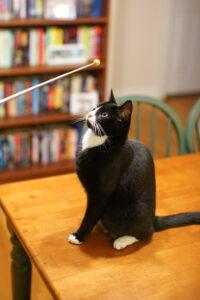If you have had a cat in the family for a while you have undoubtedly learned that cats don’t respond to punishment. However, they can be taught that their behaviors have consequences. This concept goes by the name of operant conditioning. By using positive reinforcement, you can discover how to clicker train your cat.
What Advantages Does This Training Give?
One great advantage comes when you head outdoors with your cat. In such a case, you’d best be prepared for anything. What if a sudden noise or a strange dog surprises your kitty, causing her to bolt? What if she disappears from the tent in the middle of the night? You’d better have an effective way to get your cat to respond to you.
Commands you have practiced with clicker training can come in very handy. If she has learned to respond to the clicker signal, you can call her back easily.
Now You Have A Way To Communicate

Not only will you have a way to communicate vital messages to your cat, but you will be stimulating kitty’s mind in the process. The clicker can aid in correcting behavioral issues stemming from boredom. The training also adds another form of exercise for kitty.
Just know that the positive reinforcement from clicker training will prove much more beneficial to you and the cat than any form of punishment. Too much negative reinforcement and kitty may learn to fear you instead of loving you.
Instead, when the cat responds to the clicker and then receives a treat, she will repeat that action willingly if it brings her another treat.
After all, cats already respond to signals. Does your kitty recognize the sound of the can opener, or the popping off of a cat food lid? Will she respond to the rattle of the treat bag? Think of all the auditory signals that your cat already responds to.
What Constitutes The Training Process?
Read these simple steps to the process:
1) Choose your reward, or the primary reinforcement. Will you give your cat her favorite treat, or perhaps something else kitty will respond to with enthusiasm? A favorite toy, such as a special feather, withheld for clicker training? Some petting or brushing? Just make sure to reward with something kitty especially likes.
2) Get your clicker, which becomes the secondary reinforcement. You can buy a clicker at a pet store. You could also use a ball point pen or you can click your tongue. Just make sure you choose a unique sound, so kitty doesn’t become confused.
3) Connect a click to a treat. Here’s a process for teaching the cat the meaning of the clicker. If it is to work, the cat needs to know that when the click sounds, she will get a reward.
Sit with kitty and a supply of treats. CLICK, then toss a treat…CLICK, treat; CLICK, treat…continue this action until the kitty begins to associate the sound with the treat.

Be aware that cats usually tire of the training faster than dogs. Perhaps kitty will stop after a half-dozen times. Let her choose the time period. Several short sessions will prove more beneficial than a single clicking marathon.
4) Next, pair the clicker with an action. For example, perhaps you want to teach your cat to sit on command. You will have to wait for an opportunity and be ready to click and treat. If the cat sits, click and give her the treat. You can also use a vocal command, like “sit.”
Be sure to time the click with the exact moment when the cat sits. Now you may have a cat that follows you around, sitting when you stop, and expecting a treat. It won’t take the cat too long to catch on.
5) Training sessions should be kept short — no more than five or ten minutes.
6) Rinse and repeat. Though sessions should be short, you can repeat them more than once a day if you choose.
Your Cat Learns A New Language
Clicker training teaches your kitty a new language, in effect. You must remember to stay patient. Give her time, repetition, and positive reinforcement. Eventually, you may not need a clicker — a voice command may cause kitty to respond, even though she hears no click.
By the way, if you happen to have a deaf cat, use a penlight or flashlight in place of the clicker.
Here is one YouTube video on clicker training. There are many more videos on this training that you can watch as well, so you might want to travel over to YouTube and take a look.
As an optional technique to add to the training, you can use a target stick. Fasten a treat to the end of the target stick and then use the stick to help with training.
You will need to teach your cat to follow the target. Place one, with the treat at the end, in front of his nose. When he sniffs it, click and reward the behavior.

Now, move the target next to the cat, so he must turn his head to sniff it. Again, click and reward. Continue this process, moving the target further away each time. Soon your cat will follow the target.
With the target stick, if you wish to teach your cat to sit, put the treat on the end of the target stick and move it slowly over the cat’s head. Use the “sit” command. Since the cat’s nose is pointed toward the target stick over his head, it’s a natural movement for the cat to sit. As soon as he’s closest to sitting, click, then give the treat.
Follow These Tips To Make Training Work:
1) Keep training sessions short — only a few minutes at a time.
2) Be sure you click at the right moment to indicate the behavior you desire.
3) When teaching a cat something new, start small and reward him for each step he makes along the way.
An example: To teach your cat to enter his carrier, begin by rewarding him for moving toward the case, then for standing next to it, and then for entering.
4) Don’t click more than once for a desired behavior. You may confuse kitty with multiple clicks.
5) Don’t try to move the cat where you want him to go. He must always do the moving.
6) Never punish your cat. Remember that cats respond to rewards, not to discipline.
Please be patient with your cat. Do not become discouraged if it takes the cat some time to respond to the clicker. If the treat doesn’t get him excited enough, perhaps you should try a different reward.
Though your cat may respond to the clicker for one behavior, don’t assume it will work for other behaviors. These may require additional training.
Clicker training is one of the fastest ways to establish some communication with your pet. Just remember — catch him in the act of doing something you like, click, and give him a reward. Soon the “click” should well signal that a treat is waiting nearby.
If you would like to purchase a clicker for your cat, here is a choice from Amazon. Click on the image or the blue highlighted link to be taken to Amazon, where you can make your purchase. Know that I will make a small commission if you purchase from this link.
Fun & interesting training games to play with your cat
Price: $24.95
Prime
Big Button Pet Dog Cat Training Clickers
4-pack with wrist bands
by Downtown Pet Supply
Price: $7.49
Prime
References I used for this post:
thesprucepets.com/cat-clicker-training-554058
adventurecats.org/backcountry-basics/how-to-clicker-train-a-cat/
freshstep.com/cat-tips/behavior-health/clicker-training-for-cats/



